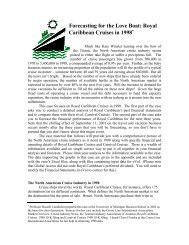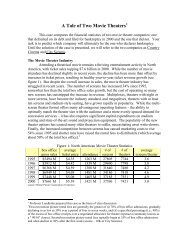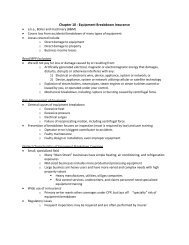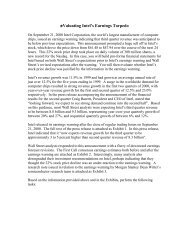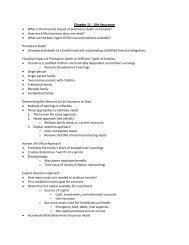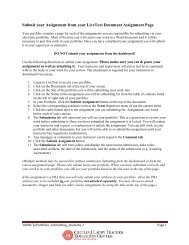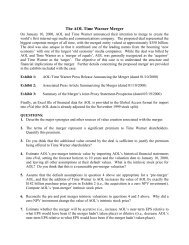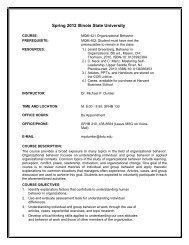Evaluating a Firm's External Environment - Illinois State University
Evaluating a Firm's External Environment - Illinois State University
Evaluating a Firm's External Environment - Illinois State University
Create successful ePaper yourself
Turn your PDF publications into a flip-book with our unique Google optimized e-Paper software.
M02_BARN4586_03_SE_C02.qxd 7/1/09 7:34 AM Page 31<br />
Chapter 2: <strong>Evaluating</strong> a Firm’s <strong>External</strong> <strong>Environment</strong> 31<br />
have been most obvious for technologies that build on digital information—<br />
computers, the Internet, cell phones, and so forth. Many of us routinely use digital<br />
products or services that did not exist just a few years ago—including TiVo.<br />
However, rapid technological innovation has not been restricted to digital technologies.<br />
Biotechnology has also made rapid progress over the past 10 years. New<br />
kinds of medicines are now being created. As important, biotechnology holds<br />
the promise of developing entirely new ways of both preventing and treating<br />
disease. 5<br />
Technological change creates both opportunity, as firms begin to explore<br />
how to use technology to create new products and services, and threats, as technological<br />
change forces firms to rethink their technological strategies. Indeed, in<br />
Chapter 1, we saw how one technological innovation—downloading digital<br />
music from the Internet—has changed competition in the music industry. 6<br />
A second element of the general environment facing firms is demographic<br />
trends. Demographics is the distribution of individuals in a society in terms of age,<br />
sex, marital status, income, ethnicity, and other personal attributes that may determine<br />
buying patterns. Understanding this basic information about a population<br />
can help a firm determine whether its products or services will appeal to customers<br />
and how many potential customers for these products or services it might have.<br />
Some demographic trends are very well known. For example, everyone has<br />
heard of the “baby boomers”—those who were born shortly after World War II.<br />
This large population has had an impact on the strategies of many firms, especially<br />
as the boomers have grown older and have had more disposable income.<br />
However, other demographic groups have also had an impact on firm strategies.<br />
This is especially true in the automobile industry. For example, minivans were<br />
invented to meet the demands of “soccer moms”—women who live in the suburbs<br />
and have young children. The 3-series BMW seems to have been designed for<br />
“Yuppies”—the young, urban, and upwardly mobile adults of the 1970s and<br />
1980s—whereas the Jeep Liberty and Nissan Xterra seem to have been designed<br />
for the so-called Generation Y—young men and women currently in their twenties<br />
and either just out of college or anticipating graduation shortly.<br />
In the United <strong>State</strong>s, an important demographic trend over the past 20 years<br />
has been the growth of the Hispanic population. In 1990, the percentage of the U.S.<br />
population that was African American was greater than the percentage that was<br />
Hispanic. However, by 2000, people of Latin descent outnumbered African<br />
Americans. By 2010, it is expected that Hispanics will constitute almost 15 percent<br />
of the U.S. population, whereas the percentage of African Americans will remain<br />
constant at less than 8 percent. These trends are particularly notable in the South<br />
and Southwest. For example, 36 percent of children under 18 in Houston are<br />
Hispanic, 39 percent in Miami and San Diego, 53 percent in Los Angeles, and 61<br />
percent in San Antonio. 7<br />
Of course, firms are aware of this growing population and its buying power.<br />
Indeed, Hispanic disposable income in the United <strong>State</strong>s jumped 29 percent, to<br />
$652 billion, from 2001 to 2003. In response, firms have begun marketing directly<br />
to the U.S. Hispanic population. In one year, Procter & Gamble spent $90 million<br />
marketing directly to Spanish-speaking customers. Procter & Gamble has also<br />
formed a 65-person bilingual team to manage the marketing of products to<br />
Hispanics. Indeed, Procter & Gamble expects that the Hispanic population will be<br />
the cornerstone of its sales growth in North America. 8<br />
Firms can try to exploit their understanding of a particular demographic<br />
segment of the population to create a competitive advantage—as Procter &




